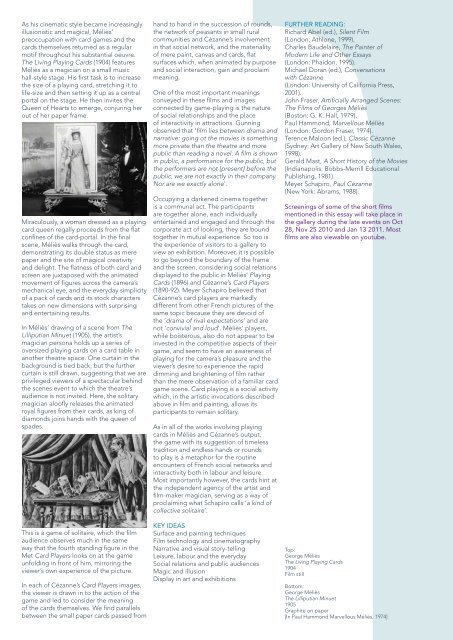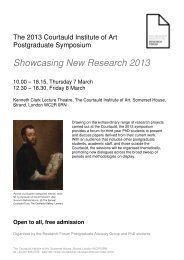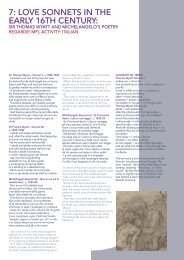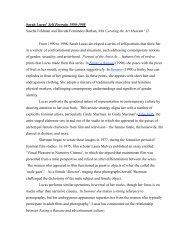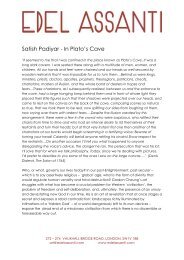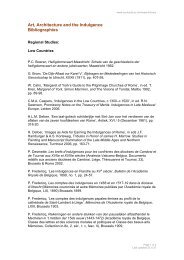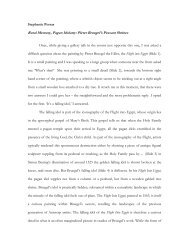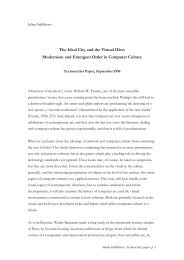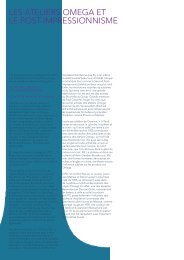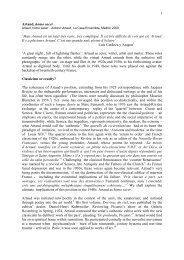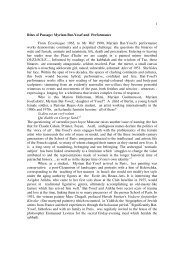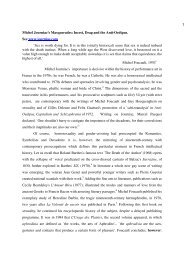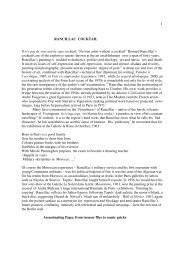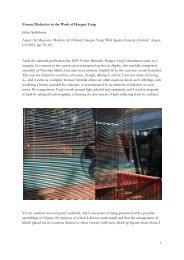TEACHERS' RESOURCE - The Courtauld Institute of Art
TEACHERS' RESOURCE - The Courtauld Institute of Art
TEACHERS' RESOURCE - The Courtauld Institute of Art
Create successful ePaper yourself
Turn your PDF publications into a flip-book with our unique Google optimized e-Paper software.
As his cinematic style became increasingly<br />
illusionistic and magical, Méliès’<br />
preoccupation with card games and the<br />
cards themselves returned as a regular<br />
motif throughout his substantial oeuvre.<br />
<strong>The</strong> Living Playing Cards (1904) features<br />
Méliès as a magician on a small music<br />
hall-style stage. His first task is to increase<br />
the size <strong>of</strong> a playing card, stretching it to<br />
life-size and then setting it up as a central<br />
portal on the stage. He then invites the<br />
Queen <strong>of</strong> Hearts to emerge, conjuring her<br />
out <strong>of</strong> her paper frame.<br />
Miraculously, a woman dressed as a playing<br />
card queen regally proceeds from the flat<br />
confines <strong>of</strong> the card-portal. In the final<br />
scene, Méliès walks through the card,<br />
demonstrating its double status as mere<br />
paper and the site <strong>of</strong> magical creativity<br />
and delight. <strong>The</strong> flatness <strong>of</strong> both card and<br />
screen are juxtaposed with the animated<br />
movement <strong>of</strong> figures across the camera’s<br />
mechanical eye, and the everyday simplicity<br />
<strong>of</strong> a pack <strong>of</strong> cards and its stock characters<br />
takes on new dimensions with surprising<br />
and entertaining results.<br />
In Méliès’ drawing <strong>of</strong> a scene from <strong>The</strong><br />
Lilliputian Minuet (1905), the artist’s<br />
magician persona holds up a series <strong>of</strong><br />
oversized playing cards on a card table in<br />
another theatre space. One curtain in the<br />
background is tied back, but the further<br />
curtain is still drawn, suggesting that we are<br />
privileged viewers <strong>of</strong> a spectacular behind<br />
the scenes event to which the theatre’s<br />
audience is not invited. Here, the solitary<br />
magician alo<strong>of</strong>ly releases the animated<br />
royal figures from their cards, as king <strong>of</strong><br />
diamonds joins hands with the queen <strong>of</strong><br />
spades.<br />
This is a game <strong>of</strong> solitaire, which the film<br />
audience observes much in the same<br />
way that the fourth standing figure in the<br />
Met Card Players looks on at the game<br />
unfolding in front <strong>of</strong> him, mirroring the<br />
viewer’s own experience <strong>of</strong> the picture.<br />
In each <strong>of</strong> Cézanne’s Card Players images,<br />
the viewer is drawn in to the action <strong>of</strong> the<br />
game and led to consider the meaning<br />
<strong>of</strong> the cards themselves. We find parallels<br />
between the small paper cards passed from<br />
hand to hand in the succession <strong>of</strong> rounds,<br />
the network <strong>of</strong> peasants in small rural<br />
communities and Cézanne’s involvement<br />
in that social network, and the materiality<br />
<strong>of</strong> mere paint, canvas and cards, flat<br />
surfaces which, when animated by purpose<br />
and social interaction, gain and proclaim<br />
meaning.<br />
One <strong>of</strong> the most important meanings<br />
conveyed in these films and images<br />
connected by game-playing is the nature<br />
<strong>of</strong> social relationships and the place<br />
<strong>of</strong> interactivity in attractions. Gunning<br />
observed that ‘film lies between drama and<br />
narrative: going ot the movies is something<br />
more private than the theatre and more<br />
public than reading a novel. A film is shown<br />
in public, a performance for the public, but<br />
the performers are not [present] before the<br />
public, we are not exactly in their company.<br />
Nor are we exactly alone’.<br />
Occupying a darkened cinema together<br />
is a communal act. <strong>The</strong> participants<br />
are together alone, each individually<br />
entertained and engaged and through the<br />
corporate act <strong>of</strong> looking, they are bound<br />
together in mutual experience. So too is<br />
the experience <strong>of</strong> visitors to a gallery to<br />
view an exhibition. Moreover, it is possible<br />
to go beyond the boundary <strong>of</strong> the frame<br />
and the screen, considering social relations<br />
displayed to the public in Méliès’ Playing<br />
Cards (1896) and Cézanne’s Card Players<br />
(1890-92). Meyer Schapiro believed that<br />
Cézanne’s card players are markedly<br />
different from other French pictures <strong>of</strong> the<br />
same topic because they are devoid <strong>of</strong><br />
the ‘drama <strong>of</strong> rival expectations’ and are<br />
not ‘convivial and loud’. Méliès’ players,<br />
while boisterous, also do not appear to be<br />
invested in the competitive aspects <strong>of</strong> their<br />
game, and seem to have an awareness <strong>of</strong><br />
playing for the camera’s pleasure and the<br />
viewer’s desire to experience the rapid<br />
dimming and brightening <strong>of</strong> film rather<br />
than the mere observation <strong>of</strong> a familiar card<br />
game scene. Card playing is a social activity<br />
which, in the artistic invocations described<br />
above in film and painting, allows its<br />
participants to remain solitary.<br />
As in all <strong>of</strong> the works involving playing<br />
cards in Méliès and Cézanne’s output,<br />
the game with its suggestion <strong>of</strong> timeless<br />
tradition and endless hands or rounds<br />
to play is a metaphor for the routine<br />
encounters <strong>of</strong> French social networks and<br />
interactivity both in labour and leisure.<br />
Most importantly however, the cards hint at<br />
the independent agency <strong>of</strong> the artist and<br />
film-maker magician, serving as a way <strong>of</strong><br />
proclaiming what Schapiro calls ‘a kind <strong>of</strong><br />
collective solitaire’.<br />
KEY IDEAS<br />
Surface and painting techniques<br />
Film technology and cinematography<br />
Narrative and visual story-telling<br />
Leisure, labour and the everyday<br />
Social relations and public audiences<br />
Magic and illusion<br />
Display in art and exhibitions<br />
FURTHER READING:<br />
Richard Abel (ed.), Silent Film<br />
(London: Athlone, 1999).<br />
Charles Baudelaire, <strong>The</strong> Painter <strong>of</strong><br />
Modern Life and Other Essays<br />
(London: Phaidon, 1995).<br />
Michael Doran (ed.), Conversations<br />
with Cézanne<br />
(London: University <strong>of</strong> California Press,<br />
2001).<br />
John Fraser, <strong>Art</strong>ificially Arranged Scenes:<br />
<strong>The</strong> Films <strong>of</strong> Georges Méliès<br />
(Boston: G. K. Hall, 1979).<br />
Paul Hammond, Marvellous Méliès<br />
(London: Gordon Fraser, 1974).<br />
Terence Maloon (ed.), Classic Cézanne<br />
(Sydney: <strong>Art</strong> Gallery <strong>of</strong> New South Wales,<br />
1998).<br />
Gerald Mast, A Short History <strong>of</strong> the Movies<br />
(Indianapolis: Bobbs-Merrill Educational<br />
Publishing, 1981).<br />
Meyer Schapiro, Paul Cézanne<br />
(New York: Abrams, 1988).<br />
Screenings <strong>of</strong> some <strong>of</strong> the short films<br />
mentioned in this essay will take place in<br />
the gallery during the late events on Oct<br />
28, Nov 25 2010 and Jan 13 2011. Most<br />
films are also viewable on youtube.<br />
Top:<br />
George Méliès<br />
<strong>The</strong> Living Playing Cards<br />
1904<br />
Film still<br />
Bottom:<br />
George Méliès<br />
<strong>The</strong> Lilliputian Minuet<br />
1905<br />
Graphite on paper<br />
[In Paul Hammond Marvellous Méliès, 1974]


